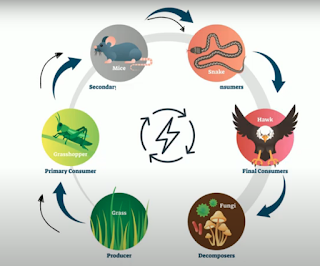In ecology, a food chain is a diagram that illustrates organisms that eat one another so that energy and nutrients are transferred from one organism to the next. For example, take a look at this food chain involving a hawk.
Notice the hawk eats the snake which eats the mice which consumes the grasshopper which consumes the producers. At each level, energy is being transferred from one organism to another.
There are a couple keywords that will help you understand a food chain. First is autotroph and heterotrophs. An autotroph which can also be called a producer creates its own food for energy. A producer may use photosynthesis or chemosynthesis. Autotrophs are the foundation of every ecosystem on the planet.
However, some autotrophs ( producers) are Chemoautotrophs that use energy from chemicals to build organic compounds without energy from the sun. This is called chemosynthesis.
A heterotroph also called a consumer, eats other organisms for their energy. A consumer that eats only plants is a herbivore.
A carnivore like a wolf eats other animals.
You may also notice in the food chain decomposers. These are organisms that gain energy by breaking down the remains of other organisms. Examples include fungi and bacteria.
Let’s take a closer look at a food chain of a fox.
At the base of the food chain lie the primary producers. The primary producers are autotrophs and are most often photosynthetic organisms such as grass.
The organisms that eat the primary producers are called primary consumers. Primary consumers are usually herbivores, plant-eaters, in this example it is a grasshopper.
The organisms that eat the primary consumers are called secondary consumers. In this example, the mouse eats the grasshopper.
The organisms that eat the secondary consumers are called tertiary consumers. In this food web, it is the fox.
Some food chains have additional levels, such as quaternary consumers—carnivores that eat tertiary consumers. Organisms at the very top of a food chain are called apex consumers.
The arrows always point in the direction of where the energy is being transferred.
The energy of the plants is transferred to the primary producers.
Related Links









0 comments:
Post a Comment